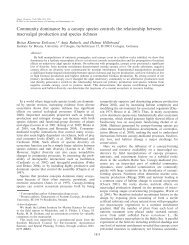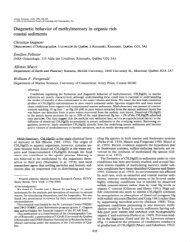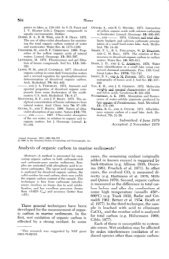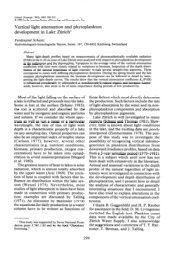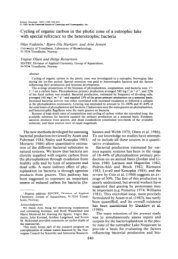Precht, Elimar, and Markus Huettel, Advective pore-water ... - ASLO
Precht, Elimar, and Markus Huettel, Advective pore-water ... - ASLO
Precht, Elimar, and Markus Huettel, Advective pore-water ... - ASLO
You also want an ePaper? Increase the reach of your titles
YUMPU automatically turns print PDFs into web optimized ePapers that Google loves.
stantially smaller filtration rate than that proposed by Riedl<br />
et al. (1972).<br />
Our experimental setup was not designed to quantify wave<br />
pumping. Nevertheless, the initial phase of Exp 2, when a<br />
rippled surface topography had not yet developed, may have<br />
indicated the magnitude of the effect of hydrostatic pressure<br />
oscillations on <strong>pore</strong>-<strong>water</strong> release (Fig. 2). During this phase,<br />
we recorded a filtration rate of 38 L m �2 d �1 . This rate must<br />
be treated as a maximum estimate, because, in our flume<br />
experiments, the ratio between sediment permeability <strong>and</strong><br />
<strong>water</strong> depth was large relative to most areas in the shelf.<br />
However, because this rate is in the range of the findings of<br />
Mu et al. (1999) <strong>and</strong> Riedl et al. (1972), we used this value<br />
as an approximation for the effects of wave pumping. The<br />
comparison of this rate <strong>and</strong> the filtration rate caused by oscillating<br />
flow–topography interaction suggests that, where<br />
wave orbital motion reaches the seabed, oscillating flow–<br />
topography interaction is more effective for <strong>pore</strong>-<strong>water</strong> exchange<br />
than wave pumping.<br />
In our wave tank, exchange rates caused by oscillating<br />
flow–topography interaction reached up to 590 L m �2 d �1 .<br />
Because our calculations were based on the maximum observable<br />
pulse of tracer release from the sediment, the resulting<br />
estimates of the <strong>water</strong> volume filtered through the<br />
sediment by wave action are minimum values. This is because<br />
the pulse maximum depends on how fast the ripples<br />
are formed, as shown by the delayed release of tracer during<br />
Exps 3 <strong>and</strong> 4, during which ripples initially formed on half<br />
the sediment surface (Exp 3) or were patchy over the duration<br />
of several hours (Exp 4). It is likely that, in these two<br />
experiments, the final filtration rates with fully developed<br />
sediment topography were higher, but by that time an assessment<br />
of the effective filtration was impossible because<br />
most of the tracer had already been washed from the upper<br />
sediment layers.<br />
Oscillating flow–topography interaction caused a clear in-<br />
Wave-driven advection<br />
Fig. 7. Schematic overview of the different sediment-<strong>water</strong> interaction processes due to surface<br />
gravity waves in coastal <strong>and</strong> shelf environments (� � wavelength). (I) In the beach zone, beach<br />
percolation can lead to very high filtering rates in a zone of limited lateral extension. In lower parts<br />
of the beach, resuspension <strong>and</strong> high sediment mobility can lead to <strong>pore</strong>-<strong>water</strong> release <strong>and</strong> particulate<br />
organic matter burial. (II) In the permanent advection zone (<strong>water</strong> depth � �/2), surface gravity<br />
waves permanently induce oscillating boundary flow that, by interacting with sediment ripples, lead<br />
to constant advective solute exchange. This advective flushing of the upper sediment layers leads<br />
to a relatively thick oxygenated sediment layer <strong>and</strong> particle transport into the bed. (III) In the<br />
episodic advection zone (<strong>water</strong> depth � � max/2), episodic advection is due to oscillating flow-sediment<br />
topography interaction (see Fig. 8). (IV) In the wave pumping zone (�/2 � <strong>water</strong> depth �<br />
�), waves are only effective for the interfacial exchange due to pumping caused by hydrostatic<br />
pressure oscillations. In deeper areas, interfacial transport is governed by diffusion <strong>and</strong> bioirrigation.<br />
1681<br />
crease of the interfacial tracer flux relative to the controls<br />
with stagnant <strong>water</strong>, but how applicable are these results to<br />
natural environments? In shallow littoral regions, hydrodynamic<br />
settings almost identical to our flume settings may be<br />
found, <strong>and</strong> in such environments we can expect effects on<br />
<strong>pore</strong>-<strong>water</strong> exchange similar to those we observed in the<br />
laboratory. In situ measurements by <strong>Precht</strong> <strong>and</strong> <strong>Huettel</strong> (unpubl.<br />
data) in a littoral zone (70 cm <strong>water</strong> depth) with s<strong>and</strong>s<br />
of comparable permeability revealed filtration rates very<br />
similar to those recorded in the wave tank. The visual observations<br />
of dye transport by Webb <strong>and</strong> Theodor (1968)<br />
confirm this transport process for a permeable rippled bed<br />
at 3 m depth. Similar observations could be made in a rippled<br />
carbonate s<strong>and</strong> bed at 18 m <strong>water</strong> depth off the East<br />
coast of Oahu (M.H. unpubl. data). Wave ripples on the seabed<br />
are frequently found in areas with <strong>water</strong> depths �100<br />
m (e.g., Cacchione et al. 1999; Ogston <strong>and</strong> Sternberg 1999).<br />
These ripples disclose that surface gravity waves generated<br />
substantial oscillating flows at these depths that were capable<br />
of moving sediment. Where the sediment is permeable<br />
enough, such flows will generate advective <strong>pore</strong>-<strong>water</strong> exchange.<br />
Natural environments—Large sections of the world’s shelf<br />
areas display conditions that allow advective processes to<br />
occur: they are covered by permeable s<strong>and</strong>y sediments, display<br />
sediment topography in form of ripples, <strong>and</strong> are permanently<br />
or episodically reached by oscillating currents.<br />
Waves dominate sediment dynamics in large shelf areas,<br />
with the majority of sediment-transport occurring during<br />
times of energetic long period waves (e.g., Wiberg <strong>and</strong> Harris<br />
1994; Harris <strong>and</strong> Wiberg 1997). The extension of the<br />
shelf areas affected by waves was numerically assessed by<br />
Harris <strong>and</strong> Coleman (1998) with the result that, for example,<br />
in the North Atlantic, wave climate was such that quartz<br />
s<strong>and</strong>s of 100 �m diameter would be mobilized down to a



